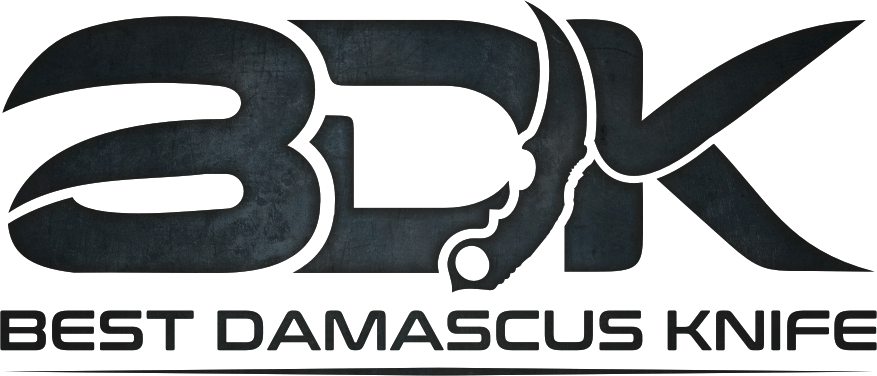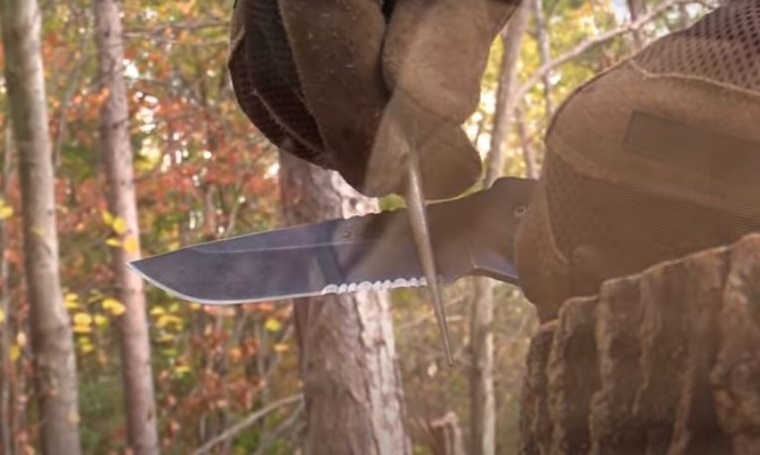It is a popular story that serrated blades cannot be honed. This is simply not right. There are numerous methods to sharpen serrated knives. Admittedly, it is not perpetually a simple job. The cheap micro-serrated knives might not yet be deserving of taking the time or purchasing the supplies to sharpen them. These and different cheap knives are usually considered “throw-away knives”, indicating once they become dull or broken, it is inexpensive to renew them fairly than fix them. And that is okay. most maximum of us starts with this sort of knife till we learn that purchasing cheap knives cost us more further in the extended run.
Learning how to sharpen a serrated knife is quite different than the straight-edge knives. Though, it is not as difficult as most utmost consider when they first begin examining the issue. Due to the serrations on the blade edge, most utmost of the blade does not even make a connection with a cutting board, prolonging the life of the blade anyhow. Connect this with a high-quality serrated bread knife that has a tempered steel blade, and you should be ready to go an extended time before even lacking to sharpen. Though, once the blade does become dull, you will see it no longer slicing cleaning through food. As this appears, the knife will begin to split or shred whatever you are cutting.
We at BestDamascusKnife are continuing to cover four distinct ways to tell you how to sharpen a serrated knife. Each method differs insignificantly in both complexity and the amount of time they use. Which you do will depend chiefly on the state of your knife, but further on which instruments you have around the house. We will explain each option, starting with the most complex and finishing with the most straightforward.
Guide: How To Sharpen A Serrated Knife
First Method: Ceramic Sharpening Rod
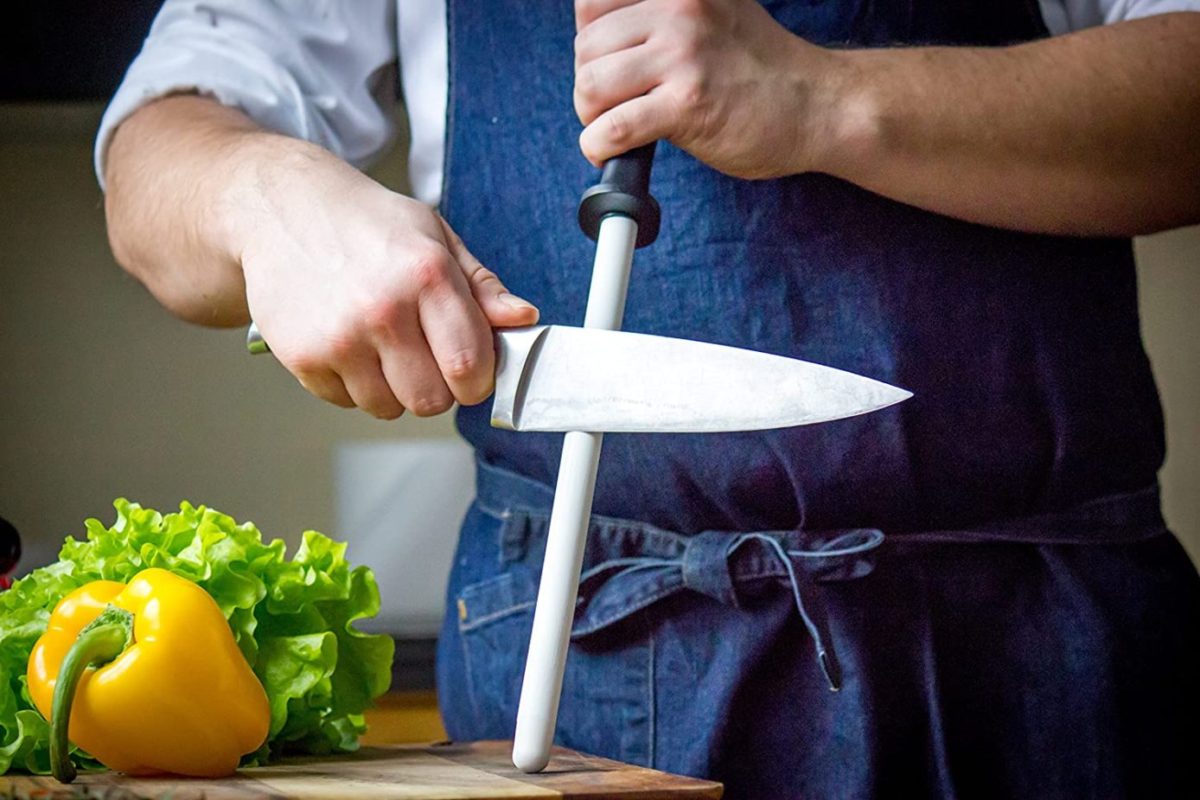
Ceramic Sharpening Rod
This one is the most complex and time-consuming method to hone a knife with serrations, but luckily, the ceramic sharpening rods are cheap. They further allow the best outcomes if your knife has gone a long time as it was far sharpened or if there are any curved points. The ceramic rod is stronger than the steel and will sharpen the scallops. The ceramic rods are extremely elegant, normally about 1000 grit. Here are the moves, including connections to the products we advise utilizing for this method.
1st Step
Take the serrated knife with the tip facing off from your body. Place the ceramic sharpening rod in every serration and attempt to meet the angle of the serrated slope as well as you can.
2nd Step
Smoothly and easily, remove the rod over the serration. Moderately than moving the rod back and forth in both ways, we advise moving the rod gently away from the blade to defend your hands from the sharp edge of the knife.
3rd Step
Repeat 2nd Step several times for all serration. This is the time-consuming section of this process, sadly. But stick with it and you will have more reliable outcomes than other methods.
4th Step
We perpetually advise transferring both sides of the knife blade across a leather strop after sharpening to additional polish the knife blade and eliminate any little burrs that were left.
Outline
That is all it needs to make a valid sharp edge on both surfaces of your serrated knife. This method is not extremely tough but is time-consuming. It does a great job of sharpening serrated knives though.
As you Read This Article You May Also Like:-
- How To Sharpen A Gut Hook
- How To Use An Exacto Knife
- How To Strop A Knife
- How To Cut Carpet
- How to Sharpen a Karambit
- How To Sharpen A Machete
- How To Use A Sharpening Stone
2nd Method: The Spyderco Sharpmaker
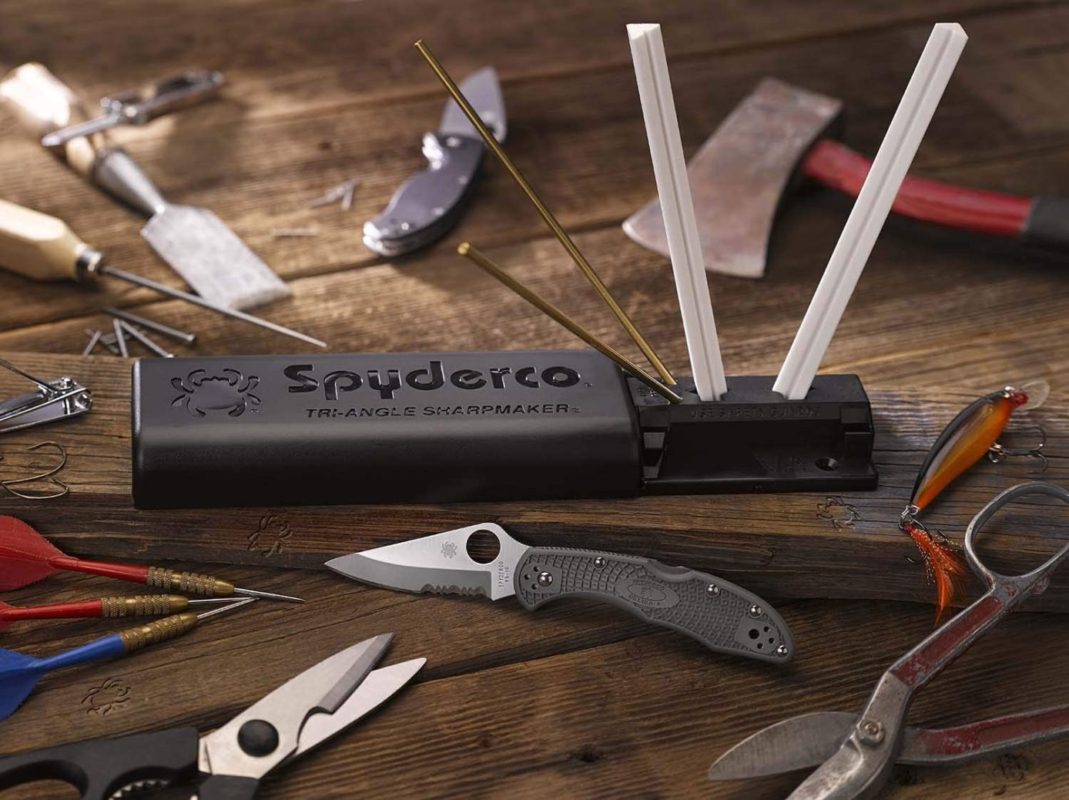
The Spyderco Sharpmaker
This process is comparable to one of the ceramic sharpening rod earlier but applies a particular tool for sharpening all kinds of knives. While this instrument is imperceptibly extra expensive than just a ceramic rod, the Spyderco Sharpmaker is yet budget-friendly for most maximum. It will furthermore help you with sharping all kinds of knives in your kitchen and workshop. For this purpose, the Sharpmaker is a highly recommended tool among sportsmen and cooks alike.
1st Step
Place the Sharpmaker instrument up on a table and put the three-sided rods in their arms. Make assured to leave the position of the rod shown on the serration side of the knife and a smooth side shown on the straight edge side of the knife.
2nd Step
Smoothly move the knife sliding over the rods at an inadequate angle, various times on every side of the blade. You will move at a more deliberate pace on the serrated side than you usually would with a straight-edge knife. Make assured to cover the whole length of the blade and “choke-up” on the knife and cover the blade in divisions if you have to.
3rd Step
Proceed with this method approximately 5 to 6 times on per side of the blade. On the serrated side of the blade, fixed the angle of the blade so that it meets the angle of the serration. On the smooth side, you will need to angle the blade simply ever very imperceptibly off of flat so that it eliminates any burrs, but does not damage the surface on the backside of the knife.
4th Step
Pass both surfaces of the serrated edge blade across a leather strop once you are finished sharpening the knife. This will additional polish the blade and eliminate any exceptional burrs that were left.
Outline
That is all it needs to make a good sharp edge on both surfaces of your serrated knife. This process is faster than the initial one and yet does a rather good job. The instrument used prices a bit more than a ceramic rod but is worth the payment if you do not previously have a method to sharpen your bread knife and necessitate to purchase something anyhow.
3rd Method: Tool Sharpener and Work Sharp’s Knife
As stated earlier, beginning with this process, we are only polishing the serrated blade with more further of a “maintenance” sharpening. For this purpose, the unique belt you will utilize on Work Sharp’s Knife and the Tool Sharpener for the serrated knives is the 6000 grit belt. Anything extra coarse than this would have more further impact on the serrations and wear them continuously. By utilizing the light grit belt, provides the knives a fine polish and holds the edges sharp.
1st Step
Learn and follow the directions that appear with the knife and tool sharpener in situation there are specifics about your knife that are distinct from this universal guide.
2nd Step
Now install the 6000 sand belt on the sharpener.
3rd Step
Lightly pull the non-serrated side of the blade over the belt. You can either simply draw the knife over numerous times or you can move back and forth with the knife.
Summary
As stated above, this will provide you a more excellent blade edge, but it will not serve as long as an initial couple of methods are presented on this page. This is a safe, simple, fast way, but will not resolve your problem if you have a particularly dull or damaged serrated knife.
4th Method: The Electric Serrated Knife Sharpener
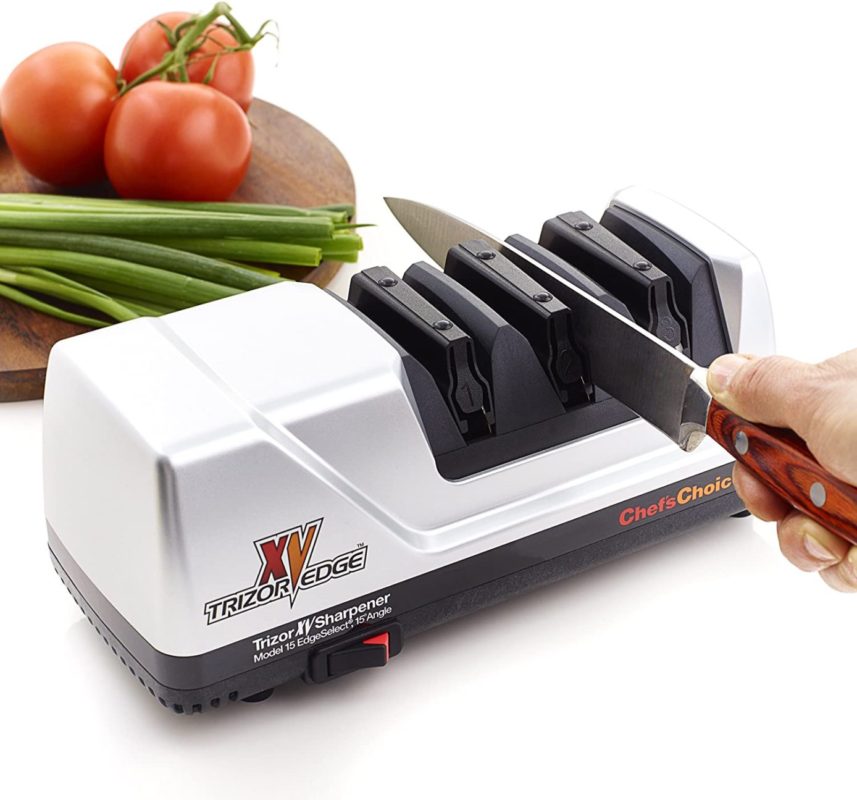
The Electric Serrated Knife Sharpener
Utilizing an electrical knife sharpener on a serrated knife is extremely like the former method. The main distinction between that machine and one similar to the Chef’s Choice Trizor XV EdgeSelect is that it has built-in leads. This executes fixing the angle of the knife super simple, but it additionally makes it less versatile. This is something you should examine when choosing which tool to buy.
If you will just be using it to sharpen kitchen knives and everything you have uses the identical edge angle, an electric knife sharpener is a fabulous choice! Where it does not make as much sense is when you need to cover all your kitchen knives, pocket knives, and the devices in your shed. That is where the Knife and the Tool Sharpener from the 3rd Method fit best.
1st Step
Perpetually read the directions that are added so you understand how to sharpen a serrated knife with your electrical sharpener. In most maximum cases with a 3-stage electric sharpener, you will just be utilizing the finest grit. This step just hones or polishes the blade’s edge, related to what a leather strop would do.
2nd Step
Put the knife’s blade in the guides of the 3rd method and move the whole length of the knife through the sharpener 4 to 5 times on every side of the knife, alternating sides every time.
Outline
Applying an electric sharpener, particularly on a serrated or bread knife, is a pretty simple job as you can perceive. Just make assured to follow the directions as not all types are the same.
Note
The first two ways are for longer-term sharpening and serrated knives that have become dulled. On the other hand, the other methods do more extra to “maintain” a valid sharp edge on the knife before it becomes extremely dull or broken. These techniques are excellent if do them more frequently and on a preventative plan rather than waiting till you have a problem.
Which Sharpener Works Best For The Serrated Knives
Several home chefs sharpen their blades themselves at their suitability or before meal prep because most maximum knife kits come with a sharpener. Not every knife sharpeners are perfect for serrated knives. Most maximum sharpeners do not have a hole for sharpening serrated knives. They are frequently made to sharpen just smooth edge blades without serrations.
Other few sharpeners have a slot built explicitly for the serrated knives. These sharpeners can reach the whole recessed portion and precisely sharpened just the side with serrations.
Utilizing the incorrect knife sharpener for your serrated knife can destroy the pointed tip. It is necessary to understand which sharpener works most suitable for serrated knives. The wrong sharpener can falsely sharpen the two sides of the blade rather of the side with serrations, and It can additionally end up sharpening just the tip without fully getting to the recessed portions
Most utmost people favor using the help of an expert when it arrives at serrated knives because the edges are distinct from non-serrated knives and it needs enough tolerance for the blade to return its razor-sharp edge when honing.
Conclusion
There are many methods one can go about how to sharpen a serrated knife. We simply described 4 useful ways to do it. The goal of this post was to acknowledge that while it is not a well-understood problem by several, it is not that tough either. Like we continually say, think of your knives as a purchase. If you purchase a firm knife built of high-quality stuff from a top knife brand that has excellent craftsmanship it will serve forever and stay sharper longer. When you do necessitate to sharpen it, you will be in a better position to do that and the new, sharper edge will last longer too.
